New Universe
by Frank
Hettick
from
SolarVoyager
Website
"Dawn in the Vega System"

"'Vega, the brightest among the 400+ stars that lie wihin 30 light-years of Old Earth, is 250% more massive than our own sun and projects almost 50 times as much light.
Late in the 20th Century on Old Earth astronomers detected a Dust-Ring circling Vega about 80 Astronomical Units out from the massive star. Continued study revealed infrared radiation emanating from the Dust-Ring - indicating the particles were not dust but much larger - large enough to indicate that a planet-building process was under way around Vega!
Although the ring circled Vega about twice the distance between Pluto and our own sun - the amount of radiation received from Vega was enough to heat the particles which then radiated the heat away from themselves in the infrared spectrum! This ability to (re)radiate that heat meant the particles were of a much larger size than microscopic!
Another surprise was the lack of any similar particle material remaining between Vega and the Ring itself - but this was the situation that should occur if a unseen planet was continuing to grow from accretion of particles, asteroids, and other orbiting materials. Could such a planet have 'scooped-up' the orbiting materials by gravitational attraction and thereby steadily increasing its' own mass?
In this image untold millennia have passed since those astronomers on Old Earth first noted the early signs of a new solar system in the construction phase!
Here Vega cannot be seen - as it is far below the horizon of this small asteroid - but the glow from the Ring can be seen clearly as we gaze from the horizon upwards towards a young planet (one of several which have been born into this new system) around which the asteroid revolves."
"Blues for Neptune"

"'Neptune is seen here some 350,000 km away in this view from the gaseous planets'
largest satellite, Triton.
The methane in Neptunes' atmosphere absorbs the red light leaving the bluish cast that characterizes the planet. Tritons' surface is covered with a thin methane frost over a perma-ice surface - a hint of a slight methane haze on the distant horizon of this strange moon can be seen.
Although Neptune and Triton each have a similar methane composition the similarity ends there - Triton orbits the planet in a retrograde 157-degree angle to Neptunes' equator. This would seem to indicate Triton was a stranger to Neptune but was captured by the gravitational attraction long ago. Triton is closer to Neptune than Luna is to Old Earth and is slowly spiraling in towards the huge planet. Sometime in the distant future Triton will break up under the influence of Neptunes' gravity and the remnants will form a ring of debris around the planet.
The indistinct horizon occurs only rarely - and is caused by the warming of methane gas as the satellites' polar cap is heated slightly by the sun (some 30-times the distance away from the sun that Old Earth is) during Tritons' 688 year-long seasonal cycle."
"Eclipse of Rigil-A"
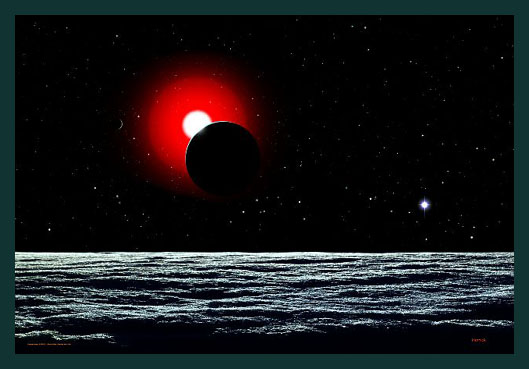
"'Perhaps best known by the grand name of Alpha Centauri and being one of the four stars in the Southern Cross - the Rigil Kent system - but not to be confused with Rigel, another brilliant star, in Orion - was first thought to be a binary system ( two stars circling one another ) by early astronomers of Old Earth - but then determined in the early years of the 20th century to be three stars - named Rigil A, B, and C.
Although orbiting one another - the three stars are never closer to one another than 11 AU (Astronomical Units) - a distance exceeding eleven times the distance from Old Earth to its' Sun. At these distances the brighter stars - Rigil A and B - have individual planets revolving around their respective sun - and be in no danger of collision or interuption of orbital activity from the other sun or its' planetary system.
The Rigel triad system is the closest planetary system to the Solar System of Old Earth - being 4.3 light years in distance and among the brightest stars visible from Earths' southern hemisphere.
This scene pictures the closer Rigil A sun being eclipsed by one of the planets in that system. Appearing as a bright star at the lower right is Rigil B. Rigil C, being a much darker star, is not visible from either Rigil A or B without optical enhancement equipment.
The proximity to Rigil A allows too much radiation (exceeding the amounts Mercury in our Solar System receives) and would most likely preclude this planet having any carbon-based life-forms. Perhaps a planet further from the sun in this sytem will yield evidence of life.
Another small moon orbiting the eclipsing planet can be seen to the left of Rigil A. The angle of view in this scene is 32-degrees."
"Martian Storm"
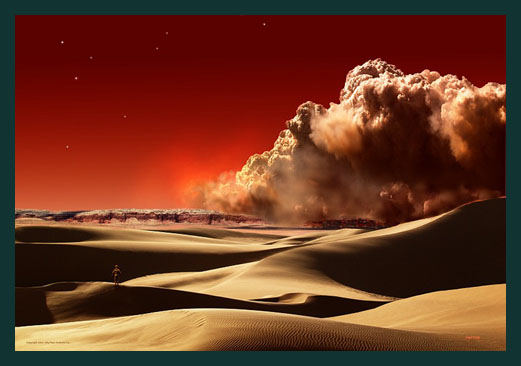
"'This explorer appears awestruck as an oncoming dust storm - although still some 50 kilometers away - moves across the surface at speeds up to one-hundred kilometers per hour. These dust storms can rise to great heights as fine iron-oxide dust particles race through the mostly carbon dioxide atmosphere.
Such dust storms are caused by the planets extremely thin atmospheric pressure - little more than 1% compared to the atmospheric pressure on Earth - which creates large temperature differentials resulting in high winds as adjacent areas of the planet rapidly heat up or cool down.
This condition of 'heating-up/cooling down' is further enhanced when the planets' southern hemisphere is tilted towards the sun - which occurs during Mars' closest approach the sun during the Martian 'summer'.
Typical temperature range at the surface is 100-degrees F. (38-degrees C.) between the warmest and coldest part of the day - with the average daily temperature being -60 degrees F - about the same as a nice day in Antartica on Earth.
This storm is moving over the far wall of a dune-filled crater as it approaches. Although the astronaut should be seeking shelter - such storms are not unusual, and several planet-wide storms that have lasted for months have been recorded.
But caution should always be the norm - as this storm lifts untold numbers of extremely fine particles of dust and grit that can scour a helmets' face-plate opaque, or even find its way into space-suit flex-joints or into precision life-support equipment.
"
"Orbiting Mars"
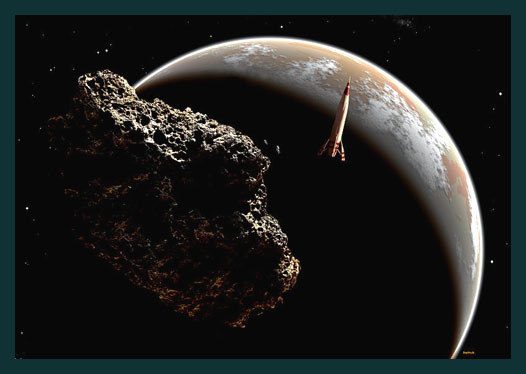
"'The dream of space travel and exploration of the solar system took a great leap
forward in the 1950's with the publication of photo-realistic illustrations that pictured man's conquest of space.
The nuclear-powered
'Mars-Liner' pictured here floats above Mars preparatory to a landing on the Red Planet. The view is reminiscent of those
early interpretations of how man might accomplish such feats. This view reflects much of what we surmised at the time of
how Mars and it's satellites might appear close-up.
The methods and equipment believed to be the answer to man's
exploration of space and other planets some fifty-years ago may appear somewhat fanciful now a half-century later -
but those early theories, math, and physics thought necessary to accomplish man's dreams proved to be a solid foundation.
And those romantic
views of needle-nosed, winged space-craft encouraged generations of young scientists and engineers to take up the challenge
of sending man to space, to the Moon, soon to Mars, and someday to other planets, perhaps even to other star systems.
This print is meant
to capture that look and feel of those early space artists such as Chesley Bonestell, Rolf Klep, and Fred Freeman that interpreted the
hard math and physics and put to paper the dreams of such engineers and scientists like Robert Goddard, Werner Von Braun, Willy Ley, and
less that two decades later - thousands and thousands of NASA personnel that would put men into Earth orbit and then on the Moon - a prelude
to accomplishing and continuing our dreams of space travel and exploration."
"Another Time, Another Place"

"A winged nuclear-powered space ship sits on the bleak and frozen surface of a small moon orbiting an Old Earth-like planet in another solar system. The explorers are now moving back towards their ship after gathering scientific data and mineral samples.
Although frozen water has been found on this moon - it is at a temperature close to absolute zero and no heat differential has been found even in the inner core. Except for a faint indication of gasses on the blurred horizon - most of the atmosphere has long since vacated into space - leaving only the frozen surface.
The few stars that are visible show an unfamiliar pattern indicating this planetary system is far removed from the Old Earth system where man first tasted space travel and exploration millennia before. This expedition has been assigned the task of mapping several planetary systems in a remote fringe section of the galaxy - so far removed from the center that the millions of stars that make up what is still referred to as the Milky Way are no longer visible.
Thousands of scout ships engaged in similar exploration continue to uncover new, startling, and undreamed-of secrets as well as proving (and just as often disproving) the earlier theories handed down through the many centuries."
"Exploration"
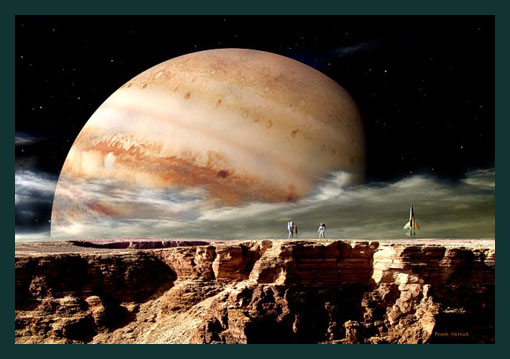
"'Exploration depicts a typical
needle-nosed space-ship with wings and fins - a styling that was popular
and very recognizable in the late 1940s and early 1950s.
This scene
pictures the large moon of a giant gaseous planet. A storm is coming
that could separate the explorers from their ship - or the sky may just
be finally clearing to allow a rare glimpse of the gas giant and stars!"
"Alignment"

"Alignment is a panoramic view of a
medium-sized planet in another star system.
The planet is large enough
to retain an atmosphere with clouds and vapor 'banding' appearing on the
horizon. A few craters on the reddish-brown surface can be made out but
no seas or lakes are visible. This is likely an early stage in the
planet's development. The temperature and pressure conditions at the
surface are such that lakes and oceans have not yet formed. Rainfall is
limited and when it does occur - will seldom even reach the planet's
surface before vaporizing and rising again.
A small moon has been
captured by the planet's gravitational attraction and has stabilized in
an orbit that puts the planet, the moon, and the sun in perfect
alignment - but will never result in a full eclipse due to the
relatively small diameter of the moon, its' distance from the planet,
and the large diameter of the sun just above and out of our view!"
"Sunrise
Over Saturn"
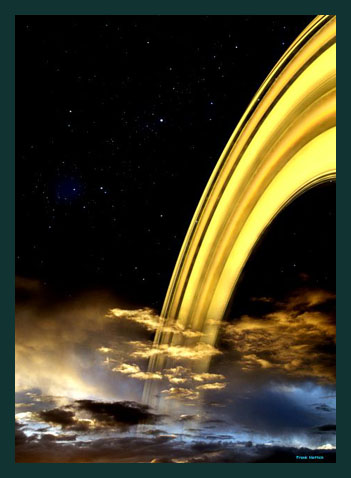
"The view is a familiar one with space
art fans - the rings of Saturn as seen from the cloud-tops of the
planet.
A view of Saturn similar to this was made famous in the late
1940's by the acknowledged master of astronomical art - Chesley
Bonestell (in The Conquest of Space - 1949). Several other versions were painted again
by Bonestell in 1961 for 'The Solar System' and again in 1970.
This is a fore-shortened view employing a narrow field of vision - and
results in a compressed 'telephoto' appearance."
"Martian Odyssey"

"Thick clouds of dust and sand obscure the alien sky in this view of a lonely Martian sub-canyon. The explorers have come prepared for this kind of weather and will continue to record the scene with their tripod-mounted equipment.
The landscape is harshly eroded from the scouring action of countless storms that have ravaged this area of the planet for eons and the brown-tinted sunlight that does manage to filter through the fast-moving dust clouds is barely enough to illuminate the many barren canyons and hills that comprise the bleak landscape.
But this visit has already proven successful - though these explorers are unaware of the values about to be unleashed! Their finds of rare and unusual mineral deposits have already made the costs of future visits of little consequence! And the potential of finding even simple life-forms under the surface still exists - especially as exploration is continuing further north near the polar cap.
Once the collected materials and scientific records being gathered are transported to the orbiting station overhead, sophisticated equipment will begin to uncover just a few of the possible treasures this 'dead' planet has available to share with humankind!"
"Sea Cliffs on Dover IV"
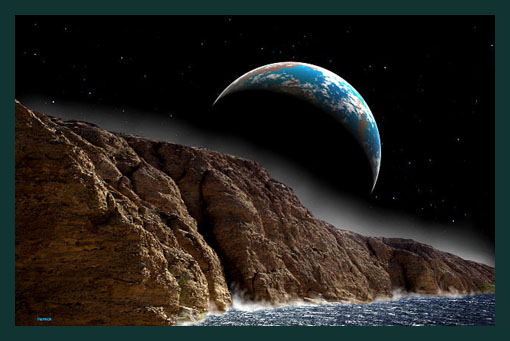
"These massive cliffs seem to reach towards the blue planet (Dover V) in the sky overhead!
The proximity of Dover V (only some 400,000 miles distant) to this planet - and each with a similar mass causes aggressive tidal actions that sweep both planets continuously. The roughly carved terrain of these great cliffs is indicative of the surfaces on both planets. And the cliff areas extending above the water - here about 2,000 feet high - are only the visible sections!
Like an iceberg on a colder planet - another 40,000 feet or more of these sheer cliffs extends downward below the surface of the sea. Early explorations of both Dover IV and V have found virtually no sandy beaches, areas of flatlands, or high mountains.
The extremely thin and inert atmospheric gases glow in the reflected light from Dover V - but on the side of Dover IV away from its twin and in the dark - no visible atmosphere can be seen! Only a light source from behind can reveal this rare glimpse!
Here the sea appears calm since it is at it's ebb. This is when the tide is at it's lowest point and occurs just before it 'turns' and begins to rise violently back to it's full! At high tide the waves will crash just below the rim-edge of these cliff-tops - and will, of course, sweep over any lower sections of the rim into the canyons beyond!
Dover IV is a rare occurrence with almost no atmosphere but a very active ocean tidal system; and very little land area! And a puzzle of science, why would the cliffs not be more worn down by the aggressive tidal action?
Perhaps this is a very recent happening caused by these planets moving too close to each other after the passage of another planetary body through the system."
"View From Moon in 16 Cygni-B System"

"A snow-covered rocky surface frozen at close to absolute zero degrees - but with sunlight reflecting off the barren surfaces and a gaseous planet floating on the horizon.
This small moon orbits a planet in the 16 Cygni B Solar System. The brightness of this moon is due to the snowy surface plus the light reaching it from a star very similar in size and brightness to our own Sun although it is still about 2.5 times as far from its sun as Earth is from the Sun.
The system and its planet were found by interpreting the gravitational influence it exerts on its own star (sun). The planet completes its journey around its sun in just over two Earth-years. Although its orbit is extremely elliptical, its orbital path averages 400 million miles from its sun - or about the same distance as our own asteroid belt (further out than Mars - but closer than Jupiter) is from our sun.
This system is 70 light years from Earth and has at least one planet that we are viewing here. Thought to be about 1.6 times the mass of Jupiter and slightly larger in diameter - this planet was one of the first extra-solar planets to be discovered. At such extreme distances robotic probes and manned exploration of such systems cannot be conducted with current or projected technology!
And the paradox facing any pioneering exploration efforts over such long distances is that the first exploration ship to finally reach its intended destination will probably be met by the ancestors of our race that were born and died millions of years after the pioneers left our own system - and had simply 'passed' the early travelers somewhere along the way!
Somewhat similar to a person setting out from Holland in a canoe and being met by someone in New York several months later that had taken an airplane just a few hours before - but still arriving first!"
"Triton Anomaly"

"Triton is the largest (2,700 km in
diameter) moon of Neptune and is almost the same size as Earth's moon!
Neptune is seen here some 570,000 miles (355,000 km) away.
Triton
is the largest satellite in our solar system known to revolve in a
direction opposite to the planets' own spin. Triton also is 'the
coldest body (yet-discovered) in our solar system' and is a mystery in
many ways! The landscape of frozen nitrogen is hard as stone with
a temperature of -235 degrees C. Perhaps Triton and its' secrets
lend credence to the legend that suggests something other than a
'natural' moon?
The space-farers in this view are intrigued and puzzled by something
(unseen by us) inside this strange edifice! Dissimilar in shape and
appearance to the frozen landscape - this 'anomaly' may also be a
stranger to Triton as are the explorers! Perhaps what first
appears as a crater from our viewpoint is a 'hatch' or 'entry-way' into
something far larger that was long ago buried under the frozen surface!
Even an entrance into the interior of Triton itself should not be
discounted!"
"Great Rift
Wall"
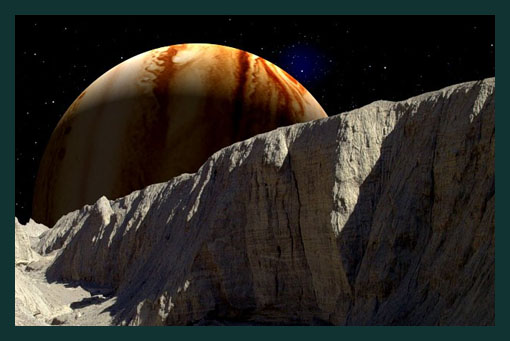
"Great
Rift Wall pictures a large geological fault on a moon of a large gaseous
planet.
The height from the top-edge of the wall to the valley floor is
almost 30,000 feet (10,000 meters) and is higher than Mt. Everest on
Earth. The section of the wall visible in this picture extends
almost 40 miles ( 25 kilometers ) into the distance - but with no
atmosphere to obscure the ridge-lines, surfaces, and horizon - the view
remains sharp and well-defined despite the relatively large distances
involved.
A faint suggestion of layered material in the shadowed areas of the
fault-wall can be made out - perhaps indicating this moon had an
atmosphere in the distant past. The valley floor below us (our
viewpoint is from half-way up the wall) may also indicate an atmosphere
had been present at some time, causing erosion of rim-material that
settled into the valley as sand or dust.
The rim-rock edges also appear
rounded - or eroded - although the distances are great enough to make
this only a suggestion rather than a conclusion until a much closer
inspection can be made."
"Remembering
Home"

"This
space-farer is gazing towards - what? Perhaps his base of operations is
just out of sight in the low-lands behind the ridge - or maybe he is
seeing only the emptiness of the landscape as he searches for his ship?
Or is he searching the skies for a glimpse of the planet that he - or
his ancestors - may have migrated from years (or centuries) earlier?
Originally titled 'Earth Remembered' the artist recently changed the
title to 'Remembering Home' - "since the new title allows the traveler
pictured to be reminiscing about a time, when he - or his ancestors -
lived on another planet and that home-planet just may not have been
Earth!"
The earlier title ('Earth Remembered') somewhat restricted the
space-person to be standing on Mars - searching the rust-colored skies
for Earth - but 'Remembering Home' opens wide the possibility of home
being totally somewhere else, perhaps even in another galaxy!"
|